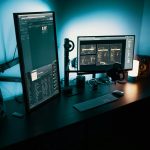When it comes to optimizing your trading experience, the right monitor setup can make all the difference. You might prefer a single ultrawide monitor for its expansive view, or perhaps a dual monitor configuration suits your multitasking needs better. For those who demand even more screen real estate, a triple monitor arrangement may be the answer. Each option has its unique advantages, so let's explore what setup might enhance your trading strategy.
Table of Contents
Key Takeaways
- A single ultrawide monitor enhances real-time market analysis, reducing eye strain and improving focus with fewer cables.
- Dual monitors provide a flexible workspace, allowing simultaneous chart analysis and trading, boosting efficiency in fast-paced environments.
- A triple monitor setup maximizes screen real estate, facilitating streamlined data management and improved visibility for serious day traders.
- Vertical monitor arrangements optimize workflow by allowing easy tracking of multiple stocks, reducing the need for window switching.
- Portable monitors are ideal for on-the-go trading, offering lightweight designs and connectivity options for flexible setups anywhere.
Single Ultrawide Monitor Setup
A single ultrawide monitor setup can be a game changer for day traders looking to maximize their screen real estate.
With its expansive display, you can easily view multiple charts, news feeds, and trading platforms side by side without the clutter of traditional monitors. This setup enhances your ability to analyze market trends in real time, allowing you to make quicker decisions.
You'll appreciate the immersive experience as you dive deeper into your trades, minimizing eye strain and improving focus. Plus, fewer cables and a cleaner workspace mean less distraction.
When you invest in an ultrawide monitor, you're not just upgrading your equipment; you're elevating your trading strategy to new heights. It's time to take your trading game to the next level.
Dual Monitor Configuration
Two monitors can significantly enhance your day trading experience, providing a flexible workspace that caters to your needs.
With a dual monitor setup, you can track multiple charts, news feeds, and trading platforms simultaneously. This configuration allows you to analyze data without constantly switching between tabs, which saves you time and reduces the risk of missing important market movements.
You can dedicate one monitor to chart analysis while using the other for executing trades or monitoring news updates. This separation increases your efficiency and focus as you navigate the fast-paced trading environment.
Moreover, having two screens minimizes clutter, making it easier to manage your workflow. Overall, a dual monitor configuration is a practical choice for serious day traders looking to optimize their trading strategy.
Triple Monitor Arrangement
Upgrading to a triple monitor arrangement takes your trading efficiency to the next level. With three screens, you can easily track multiple charts, watch real-time data feeds, and manage your trades simultaneously. This setup allows you to analyze different assets without constantly switching tabs, saving you precious time.
Here's a quick comparison of benefits:
| Feature | Triple Monitor |
|---|---|
| Screen Real Estate | More workspace for charts and tools |
| Multitasking | Streamlined data management |
| Visibility | Enhanced overview of market trends |
| Focus | Reduced distractions by organizing information |
Vertical Monitor Setup
Many day traders find that a vertical monitor setup significantly enhances their workflow. By positioning one or more monitors vertically, you can view more charts, data feeds, or news articles at once.
This setup allows you to keep an eye on multiple stocks or indices without constantly switching windows. You'll appreciate the extra vertical space for detailed price action, which can be crucial during fast-moving markets.
Adjusting your monitors for optimal height is key, as it minimizes neck strain and improves focus.
Combining a vertical monitor with a traditional horizontal setup can create a versatile workspace. You'll find that this arrangement not only boosts productivity but also helps you make quicker, more informed trading decisions throughout the day.
Portable Monitor Options
If you're always on the go, portable monitors can be a game-changer for your trading setup.
Look for lightweight designs that won't weigh you down, and explore the various connectivity options to ensure seamless integration with your devices.
Having the right portable monitor can enhance your flexibility while keeping you connected to your trades.
Lightweight Design Features
When you're day trading on the go, having a lightweight monitor can make all the difference.
You'll want a display that's easy to carry, so look for options that weigh under five pounds. Thin bezels are also important; they not only save space but enhance portability.
Consider monitors with a slim profile that easily fit into your backpack or laptop bag. Many lightweight models come with built-in stands or foldable designs, making setup quick and effortless.
Additionally, check for features like anti-glare screens, which are helpful when you're in bright environments.
With a lightweight monitor, you can stay agile and responsive, ensuring you never miss a trading opportunity, no matter where you are.
Connectivity Options Available
While you're out day trading, having the right connectivity options for your portable monitor can greatly enhance your efficiency.
You need to ensure that your monitor can easily connect to your devices. Here are some key connectivity options to consider:
- USB-C: Offers fast data transfer and power delivery in one cable.
- HDMI: Widely compatible, ensuring you can connect to most laptops and devices.
- DisplayPort: Ideal for high-resolution displays, providing excellent video quality.
- Wireless Connectivity: Reduces cable clutter and allows for flexible placement.
Choosing a portable monitor with these connectivity options will help streamline your setup and keep you focused on your trading strategy.
Multi-Screen Docking Stations
Multi-screen docking stations can transform your day trading setup into a powerhouse of efficiency and productivity. By connecting multiple monitors to a single dock, you can easily expand your display real estate.
This allows you to monitor charts, news, and trades simultaneously, enhancing your decision-making process. Many docking stations support various connections, ensuring compatibility with multiple devices.
You'll also appreciate the convenience of having a single hub for charging and data transfer, reducing cable clutter on your desk. Look for docking stations that support high resolutions and fast refresh rates to get the most out of your monitors.
With the right setup, you'll find that your trading experience becomes smoother and more effective.
Frequently Asked Questions
What Screen Resolution Is Best for Day Trading Monitors?
For optimal viewing, you'll want at least 1080p resolution for your monitors. Higher resolutions like 1440p or 4K can enhance clarity, making it easier to analyze charts and data without straining your eyes.
How Do I Choose the Right Monitor Size?
To choose the right monitor size, consider your workspace and viewing distance. A larger screen provides more detail, but ensure it fits comfortably on your desk without causing eye strain or clutter.
Can I Use TVS as Trading Monitors?
Yes, you can use TVs as trading monitors, but keep in mind their resolution and refresh rates. You'll want a model with low input lag and high resolution to ensure clear visuals for effective trading.
What Is the Ideal Refresh Rate for Trading Monitors?
For trading monitors, you'll want a refresh rate of at least 60Hz for smooth visuals. Higher rates, like 120Hz or more, can enhance responsiveness, helping you react quickly to market changes and reduce motion blur.
How Do I Manage Multiple Monitors Effectively?
To manage multiple monitors effectively, organize your workspace by designating specific tasks to each screen. Keep essential charts visible, use software that supports multiple displays, and adjust settings for optimal clarity and comfort as needed.




